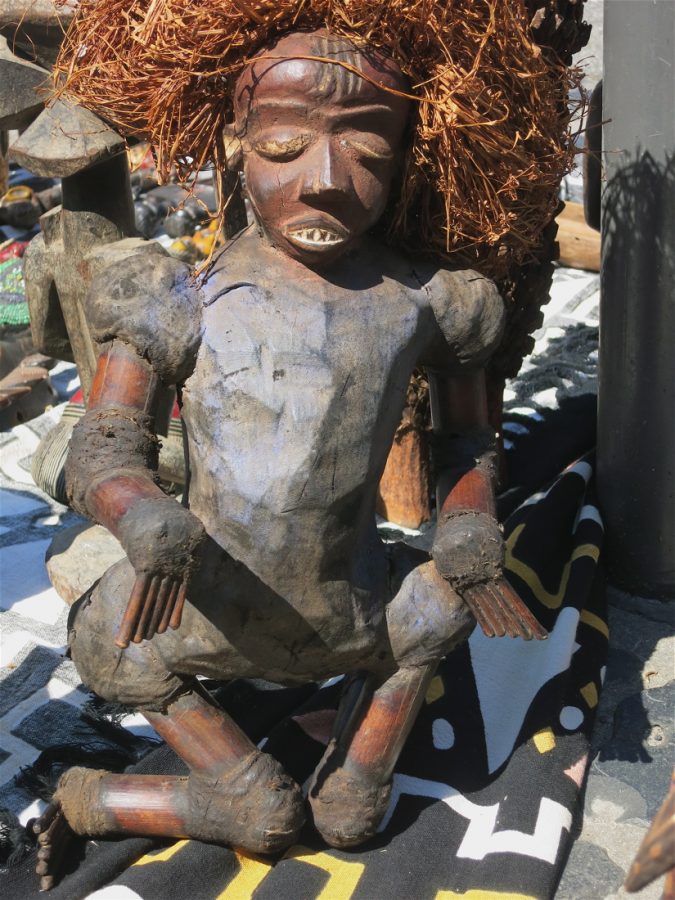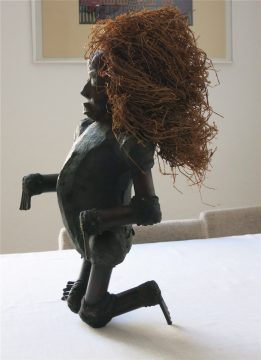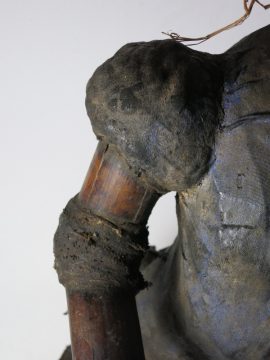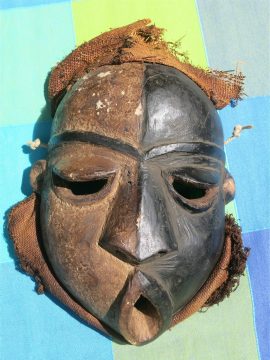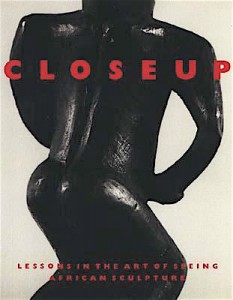A young, crippled woman came crawling along on her hands and knees. She was holding a little block of wood in her hands and had a cloth wrapped around her abdomen. Her legs were completely bent. From crawling on the ground her knees resembled the hooves of an animal. But she had a beautiful face and her eyes looked intelligent and sharp-sighted. She sat down on the ground in front of me and asked me if she could recite something to me. I held out the microphone to her and she began to sing in a beautiful and firm voice. She sang in Kiyansi and only occasionally mixed in Kikongo expressions.
1.
Mother, the man of books has come this night. I had already seen him yesterday. E ngo ya!
2.
When a child cries, you calm it down with lullabies. The fire also attacks the wood of the Mpier tree. Engo ya!
3.
The sorcerer is God’s little brother. When the white man passes by, you see him. When God passes by, will you see him too? E ngo ya!
As is customary, I put a banknote in the singer’s mouth and gave her my full palm wine glass so that she could drink and I lit her a cigarette. She crouched at my chair for a while, smoking the cigarette in a womanly manner, i.e. with the fire in her mouth, then she slid out into the night on all fours and disappeared.
Her performance had impressed me, and everyone else too; there was a long silence. They had obviously not believed she had the courage to sing such a song. I had heard some of the content; the language was OK, but I had not understood the meaning.
When I had transcribed the wording together with Bruno over the next few days, I sat down with Bruno to discuss the background of the woman’s situation and her song.
The singer’s name is Antoinette Bukibi. She was a pretty young girl when she became ill. When she had been crippled for several years, a married man from the village impregnated her. She gave birth to a healthy girl who was about two years old in 1967. I made a disapproving remark about a man impregnating a woman who can only move with difficulty. But Bruno had a different opinion: „It is good that she gave birth, so she has not lived in vain and her name will not die.“ „But who will take care of the child? The man is married and has other children,“ I objected. „The Zum will take care of the child, as he is already doing for Antoinette. You yourself heard the old Sandukumpampa say last night: ‚A fertile field – you don’t let it lie fallow.'“ (101)
J.F.Thiel transcribes, translates and interprets the text over the next few days with the help of his local assistant. Not only does the Bayansi poetics and their transformation of everyday realities come to light, but Antoinette Bukibi is also presented to us as a suffering and proud person, similar to Papa Ricky.
About the song’s content:
1. Antoinette incorporates my arrival in the village into her song. I was actually in Shie the day before with Bruno to register with the old people Kiana and Sandukum- mpampa for the evening.
2. Antoinette compares herself to a small child who is soothed with songs when it cries. The people in the village also talk to her in this way: her illness is a fate that nothing can be done about. She has to endure it. Even the large, shade-giving tree of the savannah Mpier (also called Lupier) is caught in the fire during fire hunting in the dry season and turns black; however, it does not burn. She should also be happy that she did not die. As soon as the rainy season begins, the tree sprouts again. She too has given birth to a daughter and, like Lupier, has brought forth new life.
3. Here Antoinette shows the typically traditional attitude of the Bayansi towards God: she compares him to a marten that catches chickens. The Bayansi often address God as chief. In the past they called God Nziampwu muil minawa in Kiyansi; today they like to say Mfumu Nzambi in Kikongo. Mfumu and Muil means chief. Perhaps they call God chief because, like him, he is uncontrollable and always gets his way. They have a fatalistic attitude towards God. One proverb says: „We are God’s bananas – he cuts some when they are green and others when they are ripe.“ And another says: „God has set a trap – the animals he catches with it are us humans.“ In this third verse, Antoinette seems to blame God for her situation. She will argue differently in verse 6.
4. In the fourth stanza, Antoinette compares her illness to a dream that is so obscene that she dares not tell her brothers-in-law about it. She uses the word buko (in Kikongo Bukilo) for brothers-in-law. This term refers to all in-laws. But it is certainly not the Parents in-law that are meant, because there is a strict taboo against them. However, there are joking relationships with the husband’s brothers and vice versa with the wife’s sisters (called „joking relationships“ in ethnology), as the brothers and sisters are potential marriage partners should the husband or wife die. In ethnology, this form of marriage is referred to as Levirate or Sororate. Joking relationships can also include intimacy and a lewd tone is usually permitted, especially if one party is still unmarried. If the husband goes away for a long time, he entrusts his wife to his younger brother. If a wife becomes ill or has a child, her younger sister or a cousin (i.e. a classificatory sister) often comes into the house to run the household. She is often also sexually available to the man, with his wife’s consent, because the wife is taboo to the man for almost two years after the birth of a child. Only when the father can send the child to fetch a light to light his cigarette or pipe – the child is then about two years old – is his head shaved for the first time and marital relations with the woman can be restarted.
Antoinette wants to say that her illness is as unspeakable as an obscene, even pomographic dream that she does not even dare to tell her brother-in-law, although she can have erotic relations with him. – In other words: she does not want to tell anyone about the suffering that being crippled brings her, because she is ashamed of it.
5. This verse is basically an embellishing reinforcement of the previous one. Antoinette now compares her illness to a strange, incomprehensible, even never seen event: a rooster never has horns, and if it does, then never on its calves. Her illness is incomprehensible to her. Her life has been destroyed by it.
6. The sixth verse expresses the typical traditional way of thinking: the illness is caused by a sorcerer (Muloki, in Kiyansi Ngaa mu’m). The sorcerer is called „God’s little brother“ because, like him, he causes people to die. But then Antoinette highlights the difference between him and God: the white man is a powerful man; he has everything, can do everything – according to the villagers – and yet you see him when he comes to the village or when he passes by. Perhaps she is also alluding to the previous story, when she saw me but I didn’t see her. Then comes her decisive statement: you see everyone when they pass by, even the white man. But when God passes by, you don’t see him. But if you see the white man, you will definitely see the sorcerer one day. In other words: he will be exposed and punished. She hopes that justice will prevail in the end.
On other Girls’ Songs
Not all of the Bayansi songs are as cryptic and difficult to understand as Antoinette Bukibi’s. The girls‘ songs often take aim at the social misdeeds of the people in the village. When they sing their songs in the villages in the evening, the people affected are pilloried. But the villagers agree with this approach, even if they are occasionally exposed in this way. I received always the answer that the songs help to maintain order. However, it is almost always minor offenses that are socially ostracized in this way. For example, a girl was caught stealing fish at the market. The incident will, however, reduce her bride price. Or a father washes his little daughter in the stream without considering that this could be interpreted as incest (kud’).
On June 12, 1967, I recorded numerous songs by the girls from Shie with Bruno. The most difficult thing about the songs is not understanding them linguistically, but knowing all the details of the surroundings and all the allusions. I have sometimes made recordings and had them copied word for word on the spot. When I then translated them in Europe, I realized that although I understood everything linguistically, I lacked the necessary background knowledge to understand their meaning. Some gaps could be filled in by letter, but it also happened that I took tapes back to Africa, played them to people and asked them what they were trying to suggest. It would be ideal if everything could be worked out on site. But there are often other obstacles to this. (104)
On Childish Witchcraft in Kinshasa – My Postscriptum 26. July 2024
In some aspects Antoinette resembles Papa Ricky. And in my eyes her poetry and courage rises above the singing of the street singer in Kinshasa.
But Ricky’s simple language is also full of allusions, the meaning of which is easily hidden from us Europeans and Americans. The Belgian ethnologist Filip de Boeck, who specializes in West African megacities, has been describing the changes in Kinshasa for decades – in English. I have translated a few of his articles into German and collected them in a blog chapter (LINK)
Filip de Boeck wrote 2004 in his essay ‚The Second World – Children and Witchcraft in the Democratic Republic of Congo‚ – that ‚Child witches‘ have become so numerous in the streets of Kinshasa since the 1980s that even international press agencies and our television stations report on them from time to time. Children between the ages of four and eighteen are accused of witchcraft by family members, they are said to have caused mishaps and accidents, but also illness or death. Numerous local Pentecostal churches pay much attention to the figure of Satan, demons and the battle between good and evil. During holy masses and communal prayers, the children are urged to make public confessions in which they are asked to reveal their true nature as witches and name the number of their victims.
Seldom they succeed to reconcile the ‚witches‘ with their environment, as it should traditionally work.
In general, de Boeck warns against applying Western concepts of childhood and child protection to this situation without thinking. Children in Africa are not always just victims, but are also perceived as active agents, for example in public testimony against adults who allegedly introduced them to witchcraft, as feared child soldiers (who were drafted into Kinshasa with Kabila in 1997), as financially independent young people and finally in the mythology of the big city as „sugar dolls“ who are dangerous for men and are often associated with the mami-wata mermaid, which best expresses and raises awareness of the links between sexuality, gender, age, death, access to modern material goods and the „second world“. (36-37). (…) He draws our attention to the fact that, particularly in the predominantly ‘informal’ economy, young people have better chances than adults because they are often more ‘street smart’. (p.47, note 20 to 40 in „Africa Screams“ , the catalogue of the Weltkulturenmuseum, Frankfurt 2004, ed. Tobias Wendt, pp.30-47)
In an extensive and passionate essay on the history of Kinshasa (LINK), de Boeck sums up in 2005:
• Kinshasa is getting younger and younger – youth gangs and youth culture
• The rural periphery has regained importance. While the city has become village-like in some respects, the bush is where dollars are generated and villages are transformed into booming diamond settlements.
À Suivre! Avanti!

